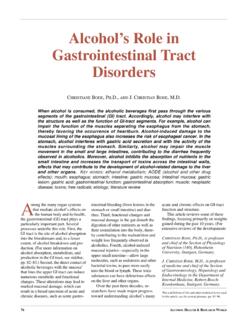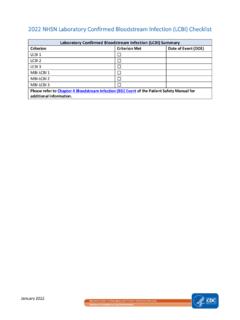Transcription of Lead in Construction
1 OSIM. Occupational Safety and Health Administration LeadinConstruction OSHA 3142 -12R 2004 O>SHX Employers are responsible for providing a safe and healthy workplace for their employ-ees. OSHA s role is to promote the safety and health of America s working men and women by setting and enforcing stan-dards; providing training, outreach and education; establishing partnerships; and encouraging continual improvement in workplace safety and health. This publication provides a general overview of a particular standards-related topic. This publication does not alter or determine com-pliance responsibilities which are set forth in OSHA standards, and the Occupational Safety and Health Act of 1970.
2 Moreover, because interpretations and enforcement policy may change over time, for additional guidance on OSHA compliance require-ments the reader should consult current OSHA administrative interpretations and decisions by the Occupational Safety and Health Review Commission and the courts. Material contained in this publication is in the public domain and may be reproduced, fully or partially, without permission. Source credit is requested but not required. This information is available to sensory impaired individuals upon request. Voice phone: (202) 693-1999; teletypewriter (TTY) number: (877) 889-5627. Lead in Construction Department of Labor Occupational Safety and Health Administration OSHA 3142-12R 2004 Contents Health Hazards of Lead Worker Construction Workers and Lead OSHA s Lead Employer Hazard Medical Medical Removal Exposure Reduction and Employee Engineering Housekeeping and Personal Protective Clothing and Respiratory Employee Information and OSHA Regional SHK Health Hazards of Lead Exposure Pure lead (Pb) is a heavy metal at room temperature and pressure.
3 A basic chemical element, i t ca n combine with various other substances to form numerous lead compounds. Lead has been poisoning workers fo r thousands of years. Lead ca n damage th e central nervous system, cardiovascular system, reproductive system, hematological system, and kidneys. When absorbed into th e body in high enough doses, lead ca n be toxic. In addition, workers lead exposure ca n harm their children s development. Short-term (acute) overexposure as short as days--can cause acute encephalopathy, a condition affecting th e brain that develops quickly into seizures, coma, and death from cardiorespiratory arrest. Short-term occupational exposures of this type ar e highly unusual but not impossible.
4 Extended, long-term (chronic) overexposure ca n result in severe damage to th e central nervous system, particularly th e brain. It can also damage th e blood-forming, urinary, and reproductive systems. There is no sharp dividing line between rapidly developing acute effects of lead and chronic effects that take longer to develop. SYMPTOMS OF CHRONIC OVEREXPOSURE Some of the common symptoms include: Loss of appetite; Constipation; Nausea; Excessive tiredness; Headache; Fine tremors; Colic with severe abdominal pain; Metallic taste in the mouth; Weakness; Nervous irritability; Hyperactivity; 3 Sffir Muscle and joint pain or soreness; Anxiety; Pallor; Insomnia; Numbness; and Dizziness.
5 REPRODUCTIVE RISKS Lead is toxic to both male and female reproductive systems. Lead ca n alter th e structure of sperm cells and there is evidence of miscarriage and stillbirth in women exposed to lead or whose partners have been exposed. Children born to parents who were exposed to excess lead levels ar e more likely to have birth defects, mental retardation, or behavioral disorders or to di e during th e first year of childhood. Workers who desire medical advice about reproductive issues related to lead should contact qualified medical personnel to arrange fo r a jo b evaluation and medical followup--particularly if they ar e pregnant or actively seeking to have a child.
6 Employers whose employees may be exposed to lead and who have been contacted by employees with concerns about reproductive issues must make medical examinations and consultations available. CHELATING AGENTS Under certain limited circumstances, a physician may prescribe special drugs called chelating agents to reduce the amount of lead absorbed in body tissues. Using chelation as a preventive measure--that is, to lower blood level but continue to expose a worker--is prohibited and therapeutic or diagnostic chelations of lead that are required must be done under the supervision of a licensed physician in a clinical setting, with thorough and appropri-ate medical monitoring. The employee must be notified in writing before treatment of potential consequences and allowed to obtain a second opinion.
7 4 Sffit Worker Exposure Lead is most commonly absorbed into the body by inhalation. When workers breathe in lead as a dust, fume, or mist, their lungs and upper respiratory tract absorb it into the body. They can also absorb lead through the digestive system if it enters the mouth and is ingested. A significant portion of the lead inhaled or ingested gets into the bloodstream . Once in the bloodstream , lead circulates through the body and is stored in various organs and body tissues. Some of this lead is filtered out of the body quickly and excreted, but some remains in the blood and tissues. As exposure continues, the amount stored will increase if the body absorbs more lead than it excretes.
8 The lead stored in the tissue can slowly cause irreversible damage, first to individual cells, then to organs and whole body systems. Construction Workers and Lead Exposure HOW LEAD IS USED In Construction , lead is used frequently for roofs, cornices, tank linings, and electrical conduits. In plumbing, soft solder, used chiefly for soldering tinplate and copper pipe joints, is an alloy of lead and tin. Soft solder has been banned for many uses in the United States. In addition, the Consumer Product Safety Commission bans th e us e of lead-based paint in residences. Because lead-based paint inhibits th e rusting and corrosion of iron and steel, however, lead continues to be used on bridges, railways, ships, lighthouses, and other steel structures, although substitute coatings ar e available.
9 Construction projects vary in their scope and potential for exposing workers to lead and other hazards. Projects such as removing paint from a fe w interior residential doors may involve limited exposure. Others projects, however, may involve removing or stripping substantial quantities of lead-based paints on large bridges and other structures. MOST VULNERABLE WORKERS Workers potentially at risk for lead exposure include those involved in iron work; demolition work; painting; lead-based paint 5 SAX abatement; plumbing; heating and air conditioning maintenance and repair; electrical work; and carpentry, renovation, and remodel-ing work. Plumbers, welders, and painters are among those workers most exposed to lead.
10 Significant lead exposures also can arise from removing paint from surfaces previously coated with lead-based paint such as bridges, residences being renovated, and structures being demolished or salvaged. With the increase in highway work, bridge repair, residential lead abatement, and resi-dential remodeling, the potential for exposure to lead-based paint has become more common. Workers at the highest risk of lead exposure are those involved in: Abrasive blasting and Welding, cutting, and burning on steel structures. Other operations with the potential to expose workers to lead include: Lead burning; Using lead-containing mortar; Power tool cleaning without dust collection systems; Rivet busting; Cleanup activities where dry expendable abrasives are used; Movement and removal of abrasive blasting enclosures; Manual dry scraping and sanding; Manual demolition of structures; Heat-gun applications; Power tool cleaning with dust collection systems; and Spray painting with lead-based paint.


















